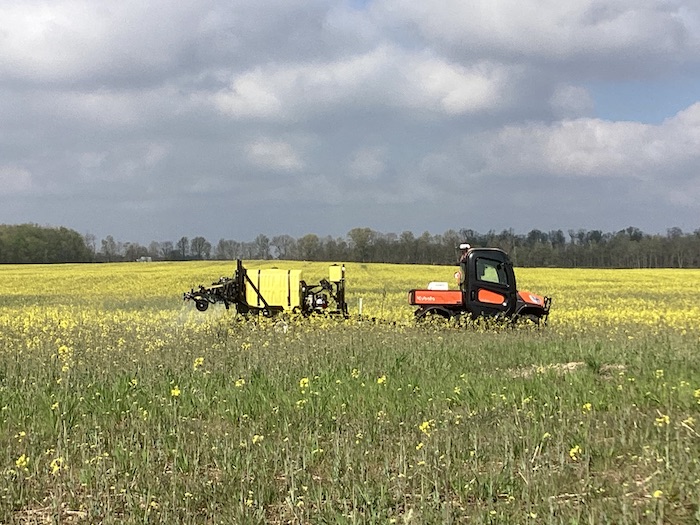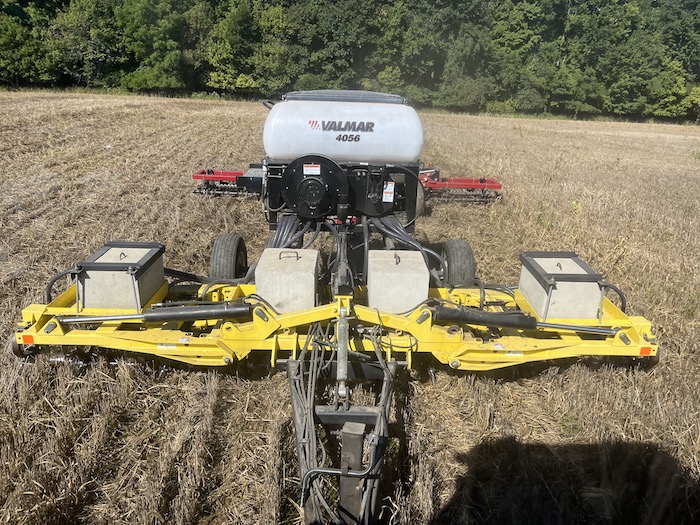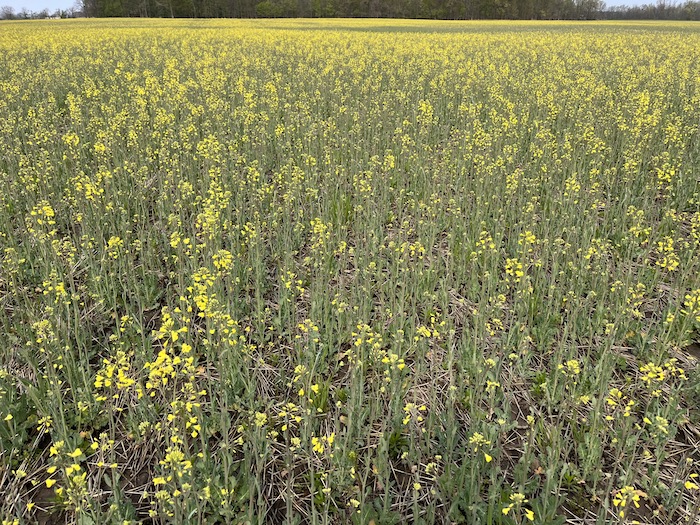Question: Just starting to do no-till with cover crops using broadcast spreader. I was wondering if anyone knows, after multiple years of no-till, when the trash builds up on top, how you sow cover crops? I'm guessing the broadcast method will not work anymore, and I will have to purchase a grain drill. If this is the case, does a grain drill have issues getting through thick layers of trash?
–Kyle Dolata, Lena, Wis.
Answer: I use a drill to seed my covers after harvest. We haven’t had tremendous luck with aerial seeding, and a drill is cheaper than a high-boy. One big benefit from drilling has been that the drill sizes the residue so it remains on the surface, but it is chopped up a bit more so it breaks down faster. You can also use a residue manager like Meltdown to help with residue breakdown. After a while, you may need to re-evaluate your plans because your soil microbes may begin to use up the residue faster than you can replenish it.
—Josh Nelson, Cardinal Prairie Farms, Belmond, Iowa
Answer:I agree with Josh. I have no problem with residue accumulation, I have no-tilled for over thirty years and just started using covers the last five. I use a JD750 drill. Broadcast is quicker but less reliable. Broadcast with a following "vertical till" tool may work well and might cover more acres faster. It might take a few years for your soil to become healthy (biologically active). Covers will help speed up that process. I estimate that residue was a problem for about 5-7 years for me but all I needed to do was put trash whippers on the corn planter. It also depends on your crop rotation, too.—Dean Weichmann, Weichmann Farm, Johnson Creek, Wis.
Answer:I looked into prices for no-till equipment as I am a small farm starting out. I bought a standard seed drill, a 22 run Massey. There are many good used low cost drills around. What I did was replace the down pressure springs with ones that are about twice as strong as the OEM springs. I also replaced the hydraulic cylinder with one 2 inches longer (next size up) and adjusted the ‘A’ position back an inch, and I use clips to fine adjust the movement, and hence the force and depth of the discs depending on how hard the soil and also cut trash.One thing I am considering is replacing the double disk openers with a single disk and a depth wheel beside each disk. I’ve made some wheels for practice by buying a piece of tube and cutting off 4-inch slices, then adding a bearing in the center. The other thing is to add a press wheel for packing each drill run. Another refinement is to run the grass seed box with a hydraulic motor so this runs independent of your ground speed.When soil is particularly hard, I may use a standard off-set disc that is set at about 2-inch depth to scratch the soil prior to seeding either a cover crop and/or cash crop. "Scratching" or scarifying the soil helps seeds get started in contact with soil, instead of just being dropped on top of the soil and trash.—Eric Jelinski, Marric Gardens, Ontario, Canada
Answer: We have used a fertilizer spreader to spread mixed cover for 22 years. We are livestock producers so we have manure to spread. We are on Hay Bay and Bay of Quinte - parts of Lake Ontario - on a point surrounded by non-farming neighbors. We do cover seeding and manure spreading after wheat harvest. The manure is liquid in full year storage concrete pits.
To preserve ammonia N, keep P out of Hay Bay and keep neighbors happy, we incorporate seed and manure on the day of spreading with a shallow - 1 1/2” - cultivation with cultivator. We are on 100% tiled heavy silty clay. Have tried injecting manure with poor results. Have settled on this system after other attempts. This is the ONLY tillage we do. All crops are no-till planted. Our farm is 1150 acres in one location. Putting “Watercombe” in Google Earth will land you on NW corner of farm.
We grow corn, soy and wheat in rotation. Corn follows manure/cover next year. Planting in residue has not been a problem. Planter has row cleaners, Keeton seed firmers and Thompson closing wheels. No coulters. Soil life is very active after 22 years. A total system approach.
—Eric Kaiser, Kaiser Lake Farms, Ontario, Canada
Answer: The crop residue won't be a problem if your soil is in shape. You may want to kick start the biology in your soil with a biological like Farm-For-Profit Step One especially if your residue is heavy. It is best applied in the fall, and I have found it works well. Once the soil is working for you, you won't have to fight the soil as hard! I like the drill for putting in cover crops just because the seed gets placed better but broadcasting is a lot quicker.—Duane Horst, Ontario, Canada
Answer: I have no luck with broadcasting cover. Also need to breakdown stubble following wheat. I put this rig together last year and it works great – 8 pounds of rapeseed seeded early September.



—Frederick Miller, Little Scioto Farms, Bucyrus, Ohio
Follow-Up Question: It's great to be part of this email thread. I'm just getting ready to help with a final till on a 3 acre parcel. It was an apple orchard on turf but the trees were diseased and not performing. The soil is water saturated and compacted so there is poor drainage but I believe this is primarily due to poor soil structure.
The plan is to do a final till shortly, then broadcast a mixed cover crop in order to increase the biomass and also to decompact the soil - 10% native seeds have been included. This will be followed by at least three microbial drenches two weeks apart and then the process of restoring the soil will begin. I'd be interested in any feedback or things to watch for.
I've never tilled land before and really all I think I want to see done with this till, is the turf flipped. What type of plow would be best for this task? The orchard will be replanted next spring with 1000 trees - mostly apple trees but also some native shrubs and trees to support the native ecology.
—Veronica Alice, Canada
Answer: Veronica; you say your soil is water saturated, is this just now in the spring, or are you on a piece of low land where the surrounding land drains towards your piece? Some tile drainage should be considered in your plans. Working soil that is wet just creates compaction and clumps of clay that dries out in the sun turning into bricks. Fruiting trees won’t do well in soil that is saturated with water. Water saturated soil does not promote the biological activity in soil for optimum growth of anything.
Systematically, say 40 foot rows of tile to a lower outlet should be the first part of any plan to recover saturated soil with poor natural drainage. Assuming tree stumps and roots have been removed leaving clumps of sod and some untouched grass between rows of trees, it could be plowed and then summer fallow and leave over winter to kill the roots of grass that have been upturned by the plow. Then disc criss-cross to smooth the field. Then for cover crop, buckwheat with clover with tillage radish. Let the cover crop include a legume and re-seed itself year after year as you replace the trees.
—Eric Jelinski, Marric Gardens, Ontario, Canada
Response: The field doesn't drain well during the wet season but dries out once the dry season begins and our dry season tends to get longer each year. The soil is compacted and currently has no structure. It's low in organic matter and all 1000 trees have been removed. They pulled out easily and had little to their root structure, they were diseased apple trees. The best way I know to begin a restoration is to flip the turf but I'm not exactly sure of which type of plow performs this task. Then I expected to harrow the surface to break up clumps and level some.
I'm inoculating the cover crop seed and will apply several microbial drenches to the soil surface. I produce and maintain my own microbe banks which I extract the biology from - I then combine this biology with stimulants for increased activity. My aim with the cover crop is to increase the organic matter using a mix of grasses in combination with brassicas to help with decompaction. This is as far as my plan goes at this time. I don't have a plan for termination yet.
It's the first time I've done something like this so it's a bit of a seat of my pants undertaking. I'm doing my best to mitigate mistakes hence my questions here. Trees of choice won't be replanted until the soil conditions improve although a few native trees may be used to help in the restoration process. I'm not sure but I suspect the drainage problem is related to poor soil structure so currently the water can't move. I figure once the soil restores there may be a natural wet area or two which will be identified and then restored as natural habitat for birds and amphibians.
Currently the entire site is compact tight turf with wet areas but we've had a lot of precipitation of late. Come summer it'll be hard, dry turf. So it is hard to say how the soil will infiltrate and drain water until it has some structure present. I really could use a lead on what type of plow to use to flip this turf and also I'd be interested in any opinions or experiential knowledge in general based on my current approach.
—Veronica Alice, Canada
Answer: Have you done a soil test? It sounds like you are lacking calcium in your soil, and probably have an excess of magnesium. That’s probably also contributing to your disease issues. A couple of applications of gypsum will help open up the soil. It won’t fix it completely, but hopefully it helps to start balancing out your ratios. It will also greatly benefit any fruiting trees you plant later on. If you do end up pulling soil samples, ask if they also test for silica. You can also throw in some sunflowers to help pull up some other nutrients deep in your soil profile. I like Eric’s recommendation of buckwheat and radishes, but you’ll want to make sure you get some grasses in there to build carbon and mycorrhiza networks. I’d also look at drenching the roots of your trees with a microbe-rich extract like a JS compost extract. A post-planting application of yucca extract may help stimulate roots and reduce transplant shock.—Josh Nelson, Cardinal Prairie Farms, Belmond, Iowa
Click HERE to sign up for the free -Till Farmer email discussion group and chime in on the conversation!



Post a comment
Report Abusive Comment